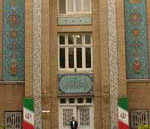First Reforms in Iranian Foreign Ministry

In April 1923 a new constitution was made for Iranian Foreign Ministry according to its needs. That was also reformed in 1931. In that year as passed by the cabinet, employees of the foreign Ministry were allowed to marry foreign women but with the permission of the ministry.
The employees who were planning to do so were to hand a complete report on their wives so that the ministry could make all the necessary inquiries and evaluate all the conditions and then permit the marriage.
This was to prevent espionage by the wives of foreign ministry employees. It was also stated that any employee who marries a foreigner without the permission of the ministry would be fired.
In 1933 when Zoka-ol-Molk Forooghi became prime minister, he chose Iranian ambassador in Iraq Bagher Kazemi as foreign minister and asked him to make a new constitution for the ministry so it can be put to action after it was studied and approved by the cabinet.
Foreign ministry handed the government a constitution that was made with a look at constitutions of other countries, and it was approved and returned to foreign ministry to be put into action on 16 February 1936. That manifest was made in 3 chapters and 27 articles. The first article was as follows:
"Ever since this constitution is enforced nobody even those already working in other governmental organizations shall be recruited to work in foreign ministry unless it is under circumstances mentioned in this constitution."
Article two had divided the members to two categories: political and counsel members and civil members.
Article Three: "Applicants for positions in foreign ministry must hold at least a bachelor degree in Law, Sociology, Economy or Commerce fields."
Another recruitment requirement was good command of spoken Persian and one of the three languages English, French or Russian and translation to and from these languages.
The political section consisted of 7 offices: first political office, second political office, third political office, forth political office, Economy office, Formalities office, Information and press.
The civil section consisted of 5 offices: office of Ministry Notes and Secrecy, Confidentiality office, Citizenship and Passport office, Recruitment office, office of Finances.
Articles 18 and 19 divided foreign ministry offices in other countries to 4 categories: Embassies, General consulates, consulates and vice consulates.
Embassies were in two categories: Grand Embassy and Embassy.
Grand Embassies were:
· Grand Embassy to Afghanistan, Kabul
· Grand Embassy to Turkey, Ankara
· Grand Embassy to Soviet Union, Moscow
Embassies were:
· The Embassy to Germany and Holland, Berlin
· The Embassy to Latin and Central America, Buenos Aires
· The Embassy to North America, Washington
. The Embassy to Great Britain, London
· The Embassy to Italy, Austria and Hungary, Rome
· The Embassy to Balkan region, Bucharest
· The Embassy to Belgium and Luxemburg, Brussels
· The Embassy to Japan, Tokyo
· The Embassy to Sweden, Norway and Denmark, Stockholm
· The Embassy to Switzerland and Czechoslovakia, Bern
· The Embassy to Iraq, Baghdad
· The Embassy to France, Spain and Portugal, Madrid
· The Embassy to Poland, Balet countries and Finland, Warsaw
· The embassy to Egypt, Saudi Arabia and Yemen, Cairo
· Secretary office in the UN, Geneva
General consulate of first degree: Syria and Lebanon, Beirut, India, New Delh: General consulate of second degree: Istanbul, Baqubah, Tiblisi, shanghai, Ashgabat, Hamburg and Herat.
First Degree consulates: Basra, Bombay, Prague and Jerusalem. Second Degree consulates: Izmir and Athens, Yerevan, Batum, Karachi, Mosul, Trabzon and Erzurum.
Third Degree consulates: Khanaqin, Rowanduz, Sulaymaniyah and Amarah.
Iranian government had vice consulates in: Damascus, Quetta, Najaf and Nakhchivan.
By year 1936 that constitution was being enforced and the number of all members of staff of foreign Ministry in different sections in and outside the country was 219. Twenty-two of them had ranking degree of 9, twenty-six had 8, thirty-one had 7, forty had 6, forty had 5 and the rest were of ranking degrees of 1-4.
Some embassies and consulates recruited local staff members who were not considered ministry staff.

